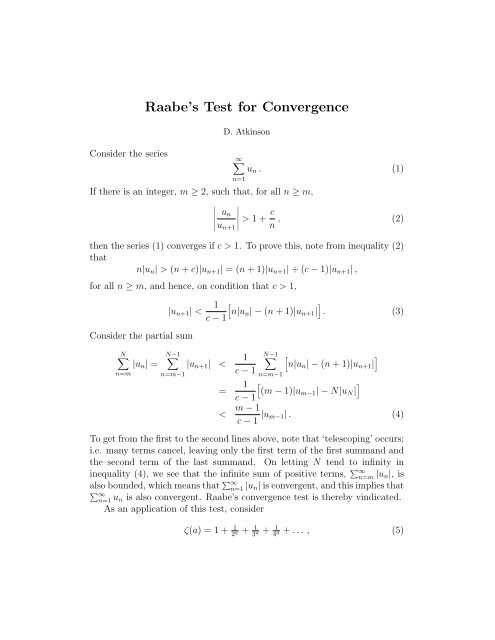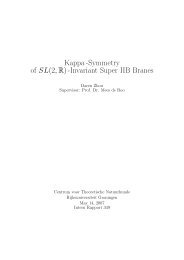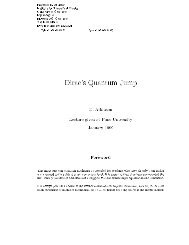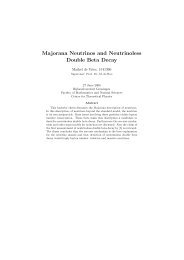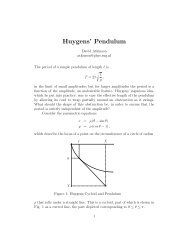Raabe's Test for Convergence
Raabe's Test for Convergence
Raabe's Test for Convergence
Create successful ePaper yourself
Turn your PDF publications into a flip-book with our unique Google optimized e-Paper software.
Consider the seriesRaabe’s <strong>Test</strong> <strong>for</strong> <strong>Convergence</strong>D. AtkinsonIf there is an integer, m ≥ 2, such that, <strong>for</strong> all n ≥ m,∞∑u n . (1)n=1∣ u ∣∣∣∣ n> 1 + c ∣u n+1 n , (2)then the series (1) converges if c > 1. To prove this, note from inequality (2)thatn|u n | > (n + c)|u n+1 | = (n + 1)|u n+1 | + (c − 1)|u n+1 | ,<strong>for</strong> all n ≥ m, and hence, on condition that c > 1,Consider the partial sum|u n+1 | < 1 [n|un | − (n + 1)|u n+1 | ] . (3)c − 1N∑N−1 ∑N−11 ∑ [|u n | = |u n+1 |
which is called the Riemann zeta-function. This series is divergent if a = 1;but we can easily show that the series is convergent <strong>for</strong> any real or complexa, such that Re a is greater than one. Evidently ζ(a) has the <strong>for</strong>m of (1),with u n = n −a , so ∣ ∣ ∣∣∣∣ u ∣∣∣∣ ( )n n + 1c= , (6)u n+1 nwhere c = Re a.We shall first show that, <strong>for</strong> 1 < c ≤ 2, the Riemann zeta-function (5) isconvergent. For n ≥ 2 the series expansion( ) n + 1 c= 1 + c n nc(c − 1) c(c − 1)(c − 2) c(c − 1)(c − 2)(c − 3)+ + + + . . .2 n 2 3! n 3 4! n 4certainly converges, and this can be rewritten( ) n + 1 c= 1 + c nn> 1 + c n ,[c(c − 1)+ 1 −2 n 2](2 − c)+3 n[c(c − 1)(2 − c)(3 − c)1 −4! n 4](4 − c)+ . . .5 n<strong>for</strong>, since 1 < c ≤ 2, the factor c − 1 is positive, the factors 2 − c, 3 − c,4 − c, . . . are non-negative, and the quantities within the square brackets alllie between 0 and 1. Using Raabe’s test, we conclude that the series (5)converges <strong>for</strong> any value of Re a in the half-open interval (1, 2].In particular,ζ(2) = 1 + 1 2 2 + 1 3 2 + 1 4 2 + . . . , (7)converges. For any Re a ≥ 2 and n ≥ 1,∣ 1 ∣∣∣ ∣ = 1n a n ≤ 1 Re a n , 2and so it follows from the comparison test, applied between (5) and (7), thatthe series (5) converges <strong>for</strong> any Re a ≥ 2, and hence <strong>for</strong> any Re a > 1.


